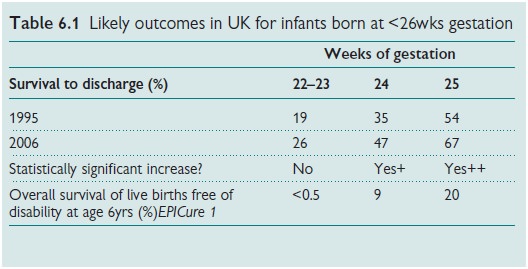Chapter: Paediatrics: Neonatology
Paediatrics: Outcome following prematurity
Outcome following prematurity
Risk of complications and
associated morbidity/mortality steadily lessen as gestation advances. Infants
who are well in the first 24hr and are >32wks gestation are at low risk of
suffering adverse outcomes. The EPICure and EPICure2 studies give the best
available guide to likely outcome in UK for infants born at less than 26wks
gestation (Table 6.1).1

Typical disabilities were;
·Cerebral palsy, most commonly
spastic (diplegia > quadriplegia > hemiplegia).
·Squint (strabismus).
·Blindness.
·Hearing loss.
·Epilepsy.
·Cognitive impairment and
behavioural disorders, e.g. attention deficit hyperactivity disorder.
Generally smaller, more immature infants
will have a poorer outcome than larger, mature babies.
Knowledge of your own unit’s
outcome is important. However, the numbers will be small, and national figures
(where available) should be used. Note that many things influence outcome, e.g.
a singleton infant, born spontaneously at 25wks gestation after an otherwise
uncomplicated pregnancy in a mother treated with 48hr of steroids, has a better
prog-nosis than a triplet born suddenly at 26wks after the mother developed
severe chorioamnionitis.
Related Topics